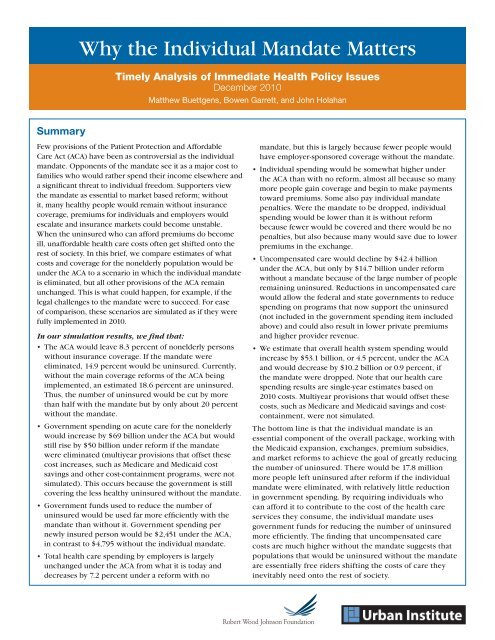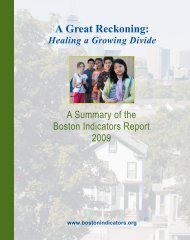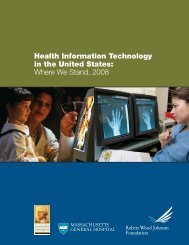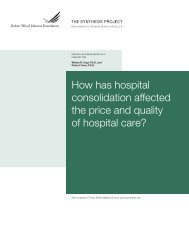Why the Individual Mandate Matters (PDF) - Robert Wood Johnson ...
Why the Individual Mandate Matters (PDF) - Robert Wood Johnson ...
Why the Individual Mandate Matters (PDF) - Robert Wood Johnson ...
You also want an ePaper? Increase the reach of your titles
YUMPU automatically turns print PDFs into web optimized ePapers that Google loves.
IntroductionFew provisions of <strong>the</strong> Patient Protectionand Affordable Care Act (ACA) havebeen as controversial as <strong>the</strong> individualmandate, <strong>the</strong> legal requirement for mostAmericans to be covered by a healthinsurance plan that meets certain minimalstandards. Many object to <strong>the</strong> mandateon individual liberty grounds. Supportersof <strong>the</strong> mandate, including policyexperts as well as insurers, insist that itis a critical component to <strong>the</strong> effectiveimplementation of comprehensive healthcare reform. Three important goals ofreform are to increase health insurancecoverage, to eliminate discrimination byhealth status in <strong>the</strong> sale and maintenanceof health insurance, and to increase<strong>the</strong> affordability of coverage. Withoutan individual mandate, <strong>the</strong>se would allbe affected by <strong>the</strong> natural tendency forpeople to want to pay for health insuranceonly when <strong>the</strong>y believe <strong>the</strong>y will needhealth care services. Since those currentlywithout insurance have significantlylower costs on average than those payingfor insurance, <strong>the</strong> mandate will bringlower-cost people into <strong>the</strong> insurancerisk pools. This would lower <strong>the</strong> averagecost per person covered and thus lowerpremiums. 1In this brief, we compare <strong>the</strong> ACA toa scenario in which <strong>the</strong> individualmandate is eliminated, but o<strong>the</strong>rprovisions of <strong>the</strong> ACA remainunchanged. This is what could happen,for example, if a legal challenge to <strong>the</strong>mandate were to succeed. 2 In particular,we compare <strong>the</strong> effects of each scenarioon <strong>the</strong> distribution of different typesof health insurance coverage, on thosewithout health insurance, and onoverall health care spending by <strong>the</strong>government, employers, and individuals.The <strong>Individual</strong> <strong>Mandate</strong>in <strong>the</strong> ACABeginning in 2014, most Americans willbe required to have health insurancecoverage meeting certain minimumrequirements and will be subject tofinancial penalties if <strong>the</strong>y do not comply.Undocumented immigrants, NativeAmericans, prisoners, and those below<strong>the</strong> tax filing threshold will be exemptfrom <strong>the</strong> mandate. Exemptions will alsobe granted for hardships in obtainingcoverage, religious conscience, situationsin which no affordable insurancecoverage is available. 3 The penalty willbe assessed and collected under <strong>the</strong> taxcode, except that <strong>the</strong>re is no criminalprosecution or additional penalty formissing payment deadlines, and nei<strong>the</strong>rliens nor levies can be used. Providersof applicable insurance plans arerequired to report relevant informationto <strong>the</strong> Internal Revenue Service and tobeneficiaries.The penalty is computed as <strong>the</strong>maximum of a flat dollar amount perperson without qualifying insurancecoverage and a percentage of <strong>the</strong> family’sincome above <strong>the</strong> tax filing thresholdfor those without qualifying insurancecoverage. Both <strong>the</strong> flat dollar amountand <strong>the</strong> income percentage are phasedin gradually from 2014 to 2016. In 2016,<strong>the</strong> flat dollar amount is $695 for anindividual, and up to three times that fora family. The income percentage in 2016is 2.5. The penalty cannot exceed <strong>the</strong>applicable national average premium forbronze-level health insurance coverageoffered through exchanges. 4MethodsTo estimate <strong>the</strong> effects of health reformand <strong>the</strong> individual mandate, we use <strong>the</strong>Urban Institute’s Health Insurance PolicySimulation Model (HIPSM). 5 HIPSMsimulates <strong>the</strong> decisions of businessesand individuals in response to policychanges, such as Medicaid expansions,new health insurance options, subsidiesfor <strong>the</strong> purchase of health insurance,and insurance market reforms. Themodel provides estimates of changesin government and private spending,premiums, rates of employer offers ofcoverage, and health insurance coverageresulting from specific reforms. 6We simulate <strong>the</strong> main coverageprovisions of <strong>the</strong> ACA is if <strong>the</strong>y werefully implemented in 2010 and compareresults to <strong>the</strong> HIPSM baseline results for2010 prior to implementation of <strong>the</strong>sereforms. This approach differs from thatof <strong>the</strong> Congressional Budget Office or <strong>the</strong>CMS actuaries who by necessity provide10-year estimates. Our approach permitsmore direct comparisons of reform with<strong>the</strong> pre-reform baseline and of variousreform scenarios with each o<strong>the</strong>r. Thekey coverage provisions of <strong>the</strong> ACA and<strong>the</strong>ir implications for coverage and costswere summarized in an earlier policybrief. 7 To demonstrate <strong>the</strong> effect of <strong>the</strong>individual mandate, we also simulatea health reform with <strong>the</strong> individualmandate omitted but including <strong>the</strong> o<strong>the</strong>rcoverage provisions of <strong>the</strong> ACA. Thisallows us to estimate what could resultif, for example, legal challenges to <strong>the</strong>mandate were to succeed.To model <strong>the</strong> individual mandate, webegin with <strong>the</strong> baseline HIPSM model,in which behavior is calibrated to agreewith results from <strong>the</strong> empirical heal<strong>the</strong>conomics literature. The resultingmodel behavior is applicable for avoluntary health insurance regime,whereas we must also simulate howbehavior would change in <strong>the</strong> presenceof a mandate. Since a similar law onlyexists in Massachusetts after its healthreforms, <strong>the</strong> only available empiricaldata are from that state. 8 Our simulationof how behavior would change under<strong>the</strong> mandate has three components:1. The applicable financial penalty.A computation of whe<strong>the</strong>r <strong>the</strong>penalty is applicable and <strong>the</strong> amountof <strong>the</strong> penalty as defined by <strong>the</strong>law, i.e., <strong>the</strong> fully phased in amountdiscounted to present dollars.2. An additional “disutility” of notcomplying with <strong>the</strong> mandate.The mandate is more than a dollaramount, it is a legal requirement.Desire to comply with <strong>the</strong> law, or atleast to avoid enforcement and <strong>the</strong>stigma of noncompliance, can lead tobehavioral responses much strongerthan <strong>the</strong> amount of <strong>the</strong> nominalpenalty would suggest as appears tobe <strong>the</strong> case in Massachusetts. Themandate has <strong>the</strong> effect of makingbeing uninsured less desirable. Weoperationalize this in <strong>the</strong> modelby applying an additional “psychicpenalty” to being uninsured. 93. A relatively small “spillover”disutility of being uninsuredon populations not bound byTimely Analysis of Immediate Health Policy Issues 2
<strong>the</strong> mandate. The mandate inMassachusetts was associated withan increase in coverage among thosenot actually bound by <strong>the</strong> mandate.We assume that this association wasdriven, in part, by a spillover effect of<strong>the</strong> mandate on those who were notbound by it who ei<strong>the</strong>r mistakenlyassumed <strong>the</strong>y were or who reacted toa new social norm to have coverage.In addition to uncertainty about<strong>the</strong> current applicability of <strong>the</strong>mandate, people may also be makinga judgment about whe<strong>the</strong>r <strong>the</strong>y willlose <strong>the</strong>ir mandate exemption in<strong>the</strong> future due to rising income. Forthose exempt from <strong>the</strong> mandate, <strong>the</strong>amount of additional disutility ofbeing uninsured is far smaller thanfor those bound by <strong>the</strong> mandate.ResultsChanges in HealthInsurance CoverageWe begin by examining how <strong>the</strong>distribution of health insurance coveragediffers in <strong>the</strong> three scenarios simulated.Table 1 gives detailed results, whileFigure 1 shows <strong>the</strong> percentages ofnonelderly persons with various typesof coverage. Without health reform,18.6 percent of nonelderly persons(49.9 million) would be without healthinsurance. 10 Under <strong>the</strong> ACA, <strong>the</strong>re wouldbe a dramatic increase in coverage: only8.3 percent (22.1 million) would bewithout insurance. As we have shown inan earlier policy brief, nearly two-fifthsof <strong>the</strong>se are eligible for Medicaid or CHIPbut have not enrolled, and just over aquarter are undocumented immigrantsbarred from <strong>the</strong> benefits of healthreform. 11 If <strong>the</strong> individual mandate weredropped, insurance coverage would besignificantly lower; 14.9 percent (39.8million) would be without insurance.Without a mandate, <strong>the</strong> net increase ininsurance coverage is due entirely to<strong>the</strong> expansion of Medicaid. In fact, <strong>the</strong>share of nonelderly persons covered byprivate health insurance would actuallydecline from 62.1 percent without reformto 61 percent under reform with nomandate, largely because some wouldleave private coverage to enroll in <strong>the</strong>expanded Medicaid program or to takeadvantage of subsidies in <strong>the</strong> exchanges. 12With a mandate, enrollment in <strong>the</strong> newhealth insurance exchanges as well as inemployer-sponsored insurance would benoticeably higher, with 66.3 percent of <strong>the</strong>nonelderly covered by private insurance.Without health reform, 42.9 millionnonelderly Americans would be enrolledin Medicaid or CHIP. Under health reform,eligibility for Medicaid will be expandedto 133 percent of <strong>the</strong> federal poverty levelwith a 5 percent income disregard. 13 Thisis <strong>the</strong> same with or without a mandate,so we would see a significant increase inenrollment under ei<strong>the</strong>r reform scenario(55.6 million without a mandate and 59.7million with a mandate). The mandatewould increase Medicaid enrollmentby several million people, due to <strong>the</strong>behavioral effects we describe above.Table 1. Health Insurance Coverage Distribution of <strong>the</strong> Nonelderlyin Baseline and ReformCoverage (in millions)Percent of <strong>the</strong> non-elderly100%75%50%25%0%18.6%19.3%5.5%56.6%Without reformWithout reform8.3%25.5%9.8%56.4%Reform with mandateReform withmandate14.9%24.0%6.8%54.4%Reform withoutmandateReform withoutmandatePrivate 166.4 62.1% 177.5 66.3% 164.0 61.2%Employer (non-exchange) 151.6 56.6% 130.4 48.7% 127.4 47.6%Nongroup (non-exchange) 14.8 5.5% 3.3 1.2% 2.6 1.0%Exchange employer n.a. n.a. 20.7 7.7% 18.2 6.8%Exchange nongroup n.a. n.a. 23.1 8.7% 15.7 5.8%Medicaid/CHIP 42.9 16.0% 59.7 22.3% 55.5 20.7%O<strong>the</strong>r (including Medicare) 8.7 3.2% 8.7 3.2% 8.7 3.2%Uninsured 49.9 18.6% 22.1 8.3% 39.8 14.9%Source: Urban Institute analysis, HIPSM 2010.Note: We simulate <strong>the</strong> provisions of <strong>the</strong> Affordable Care Act as if fully implemented in 2010.Figure 1. Health Insurance Coverage Distribution of <strong>the</strong> Non-ElderlyUninsuredPublicNongroupESITimely Analysis of Immediate Health Policy Issues 3
The UninsuredMost of <strong>the</strong> impact of eliminating <strong>the</strong>mandate would fall on those below200 percent of <strong>the</strong> FPL. Without healthreform, <strong>the</strong> uninsured are heavilyconcentrated among those with incomesbelow 200 percent of <strong>the</strong> federal povertylevel (FPL). Under <strong>the</strong> ACA, <strong>the</strong>rewould be only 13.7 million uninsuredin this income group, as opposed to33.1 million uninsured without reform(Figure 2). Under health reform withno mandate, <strong>the</strong> number of uninsured$1,000$800$600$400$200$0nonelderly persons below 200 percentof <strong>the</strong> FPL would be 21 million, 7.3million more than with <strong>the</strong> mandate.Changes in Health Care SpendingFigure 2. Non-elderly Uninsured Below 200% of <strong>the</strong> FPLbillions $Persons (in millions)3530252015105033.1Without reformFigure 3 shows how spending on acutecare for <strong>the</strong> nonelderly would differwithout reform, with reform excluding<strong>the</strong> mandate, and with reform including<strong>the</strong> individual mandate. As noted earlier,we do not simulate offsetting multiyearcost control provisions or provisionssuch as eliminating enhanced paymentsto Medicare HMOs. Single-year estimates$1,400 UncompensatedCare$70$27$55$1,200<strong>Individual</strong>$340$513$244Without reform$370$51013.7$332$476$313 $294Reform with mandate Reform without mandate$1,168 $1,221Reform with mandate Reform without mandateFigure 3. Net Health Care Spending of <strong>the</strong> Government, Employers,<strong>Individual</strong>s, and Uncompensated Care—Acute Care, Nonelderly$1,15721.0EmployerGovernmentbased on 2010 costs are presented,which do not reflect <strong>the</strong> effects ofmultiyear cost savings and Medicare andMedicaid cost savings. Under <strong>the</strong> ACA,<strong>the</strong> amount spent on uncompensatedcare would fall from $70 billion in<strong>the</strong> baseline to $27 billion due to <strong>the</strong>expansion of health insurance coverage.Spending by individuals would increasefrom $340 billion to $370 billion.Many more people would purchaseinsurance; this cost would be partiallyoffset by cost savings in <strong>the</strong> exchanges.Employer spending would declineslightly. Government spending on acutecare for <strong>the</strong> nonelderly would risefrom $244 billion to $313 billion dueto <strong>the</strong> Medicaid expansion and varioussubsidies. In total, system spending onhealth care would rise 4.5 percent from$1,168 billion without reform to $1,221billion under <strong>the</strong> ACA.If <strong>the</strong> mandate were dropped fromhealth reform, uncompensated carewould rise to $55 billion because <strong>the</strong>rewould be many more without healthinsurance. <strong>Individual</strong> and employerspending would fall somewhat dueto cost savings in <strong>the</strong> exchangesand a decline in private healthinsurance coverage. Governmentspending would decline modestlyto $294 billion, $19 billion less thanwith <strong>the</strong> mandate; governmentspending remains high becausewithout a mandate, reform covers alarge number of less healthy people.Overall, acute health care spending by<strong>the</strong> nonelderly would be $1,157 billion,modestly lower than with no reform,primarily because Medicaid and <strong>the</strong>costs of exchange plans substitute forhigher cost private insurance.Table 2 shows more detail on howgovernment spending on acute healthcare for <strong>the</strong> nonelderly changes under <strong>the</strong>three scenarios simulated. Governmentcosts are significantly higher under <strong>the</strong>ACA because of <strong>the</strong> Medicaid expansion,as well as subsidies for exchangecoverage and small employers. Under<strong>the</strong> ACA, spending on acute care for <strong>the</strong>nonelderly through Medicaid and CHIPwould increase by $53.6 billion; $37.5Timely Analysis of Immediate Health Policy Issues 4
illion would be spent on total subsidies(premium, cost-sharing, and employer).Offsetting some of this spending, $17.6billion would be collected in employerassessments and $4.3 billion in individualmandate penalties.If <strong>the</strong> mandate were dropped fromhealth reform, Medicaid and CHIPspending would fall by $12.6 billion.Eliminating <strong>the</strong> mandate does not affecteligibility for <strong>the</strong>se programs, but doesreduce <strong>the</strong> enrollment of those eligible.Total spending on subsidies (premium,cost-sharing, and employer) wouldbe $26.8 billion, and <strong>the</strong> governmentwould collect $17.8 billion in employerTable 2. Health Care Spending of <strong>the</strong> GovernmentGovernment Spending aWithoutreform(in millions)Reform withmandate(in millions)assessments. The lower exchangeenrollment without a mandate leads tolower, but still substantial, premiumand cost-sharing subsidies. Without amandate, <strong>the</strong>re is less worker demandfor ESI coverage and thus lower rates ofemployers offering coverage and lowerrates of workers taking up offers. As aresult, employer subsidies are lower andassessments are higher.Under <strong>the</strong> ACA, total employer healthcare spending would decrease slightly(Table 3). Employers would have lowerpremium contributions because ofcost savings in <strong>the</strong> exchange and smallemployers would benefit from subsidies,Change(in millions)Reformwithoutmandate(in millions)Change(in millions)Medicaid/SCHIP $244,180 $297,740 $53,560 $285,070 $40,890Premium subsidies n.a. $26,860 $26,860 $18,578 $18,578Cost-sharing subsidies n.a. $6,090 $6,090 $4,543 $4,543Employer subsidies n.a. $4,479 $4,479 $3,738 $3,738<strong>Individual</strong> mandates n.a. -$4,290 -$4,290 n.a. n.a.Employer assessments n.a. -$17,601 -$17,601 -$17,761 -$17,761Net government spending $244,180 $313,277 $69,097 $294,168 $49,988Source: Urban Institute analysis, HIPSM 2010.Note: We simulate <strong>the</strong> provisions of <strong>the</strong> Affordable Care Act as if fully implemented in 2010.a Spending on acute care for <strong>the</strong> non-elderly.Table 3. Health Care Spending of EmployersEmployer SpendingWithoutreform(in millions)Reform withmandate(in millions)Change(in millions)Reformwithoutmandate(in millions)Change(in millions)ESI premiums $513,293 $494,068 -$19,225 $459,579 -$53,714Employer assessments n.a. $17,601 $17,601 $17,761 $17,761Voucher amount n.a. $2,995 $2,995 $2,688 $2,688Employer subsidies n.a. -$4,479 -$4,479 -$3,738 -$3,738Net employer spending $513,293 $510,185 -$3,108 $476,290 -$37,003Source: Urban Institute analysis, HIPSM 2010.Note: We simulate <strong>the</strong> provisions of <strong>the</strong> Affordable Care Act as if fully implemented in 2010.but at <strong>the</strong> same time face significantemployer assessments.Without a mandate, total employerhealth care spending would declinecompared with <strong>the</strong> ACA by $34 billionor 6.7 percent (from $510.2 billion to$476.3 billion). Employer spendingwith no mandate is significantlylower than spending under <strong>the</strong> ACAdue primarily to <strong>the</strong> total spent inESI premium contributions. Nearly 7million more people are covered byemployer-sponsored insurance when<strong>the</strong> individual mandate is in effect thanunder reform without a mandate.<strong>Individual</strong> spending on acute care for<strong>the</strong> nonelderly would be $29.5 billionhigher under <strong>the</strong> ACA than withoutreform, $370.0 billion versus $340.5billion. This is due to <strong>the</strong> substantialexpansion of private insurancecoverage. This is partially offset bysavings in <strong>the</strong> exchanges. Note thatout-of-pocket cost sharing declinessignificantly even with increasedcoverage. This means that insurancecoverage under <strong>the</strong> ACA is in generalmore comprehensive than withoutreform due to <strong>the</strong> Medicaid expansionand insurance market reforms,particularly in <strong>the</strong> nongroup market.Those below 200 percent of <strong>the</strong> FPLwould see a substantial reduction in<strong>the</strong>ir spending, $10.7 billion, due <strong>the</strong>exchange subsidies and <strong>the</strong> Medicaidexpansion. Those with higher incomeswould pay more in total due tospending by those newly purchasingprivate insurance.Without a mandate, individualspending would be $332.2 billion,much lower than under <strong>the</strong> ACA.<strong>Individual</strong> spending falls without amandate because of <strong>the</strong> decline inprivate coverage. Health reform with<strong>the</strong> individual mandate would cover 18million more people than without <strong>the</strong>mandate. Of <strong>the</strong>se, 14.5 million wouldbe covered by private health insuranceand would have to pay some share of<strong>the</strong> premiums for this coverage.Uncompensated care provided to <strong>the</strong>uninsured is currently a substantial costTimely Analysis of Immediate Health Policy Issues 5
for federal, state, and local governments,health care providers, and o<strong>the</strong>rs.Hadley et al. (2008) find that aboutthree-quarters of uncompensated careis financed by federal, state, and localgovernments, through DSH payments,and o<strong>the</strong>r programs. 14 Under <strong>the</strong> ACA,uncompensated care declines by $42.3billion to $27 billion (Figure 3). Withouta mandate, uncompensated care wouldremain high ($55 billion) due to <strong>the</strong>additional 18 million people withou<strong>the</strong>alth insurance. Programs that supportuncompensated care would have to belargely maintained.Government Costs perNewly InsuredBecause <strong>the</strong> uninsured are heavilyconcentrated in <strong>the</strong> income groupseligible for Medicaid and exchangesubsidies, it makes sense to consider<strong>the</strong> government costs per newlyinsuredperson (here <strong>the</strong> governmentcosts of acute care for <strong>the</strong> nonelderly)as a measure of <strong>the</strong> efficiency of ahealth reform scenario. The differencebetween reform with and without anindividual mandate is dramatic. Withouta mandate, <strong>the</strong> average cost per newlyinsuredwould be $4,795; under <strong>the</strong> ACAit would be far lower, $2,451 (Figure4). The increase in coverage withouta mandate was due entirely to <strong>the</strong>Medicaid expansion, so that nearly allTable 4. Health Care Spending of <strong>Individual</strong>s<strong>Individual</strong> SpendingWithoutreform(in millions)Reform withmandate(in millions)newly insured have <strong>the</strong>ir costs borneby <strong>the</strong> government. With <strong>the</strong> ACA’sindividual mandate, half of <strong>the</strong> newlyinsured would have private coverageand half public coverage.Premiums in <strong>the</strong> ExchangesAn important argument used byadvocates of an individual mandateis that <strong>the</strong>re would be substantialadverse selection in <strong>the</strong> exchangewithout it, leading to higher premiums.Our simulation confirms that adverseselection would result, but <strong>the</strong> amountis not large (Table 5). The reason for thisis <strong>the</strong> presence of premium and costsharingsubsidies. Under <strong>the</strong> ACA, weestimate that about two thirds of thosecovered in <strong>the</strong> nongroup exchangeswould be in <strong>the</strong> subsidy eligibilityrange. 15 As we have seen, exchangeenrollment would be significantlylower without a mandate, but most of<strong>the</strong> difference would come from thoseabove <strong>the</strong> subsidy eligibility threshold.Those eligible for subsidies are onaverage younger than <strong>the</strong> populationat large and have lower average costs.Thus, <strong>the</strong>re would be a large pool oflower-than-average-cost enrollees in <strong>the</strong>exchanges with or without a mandate,moderating <strong>the</strong> effects of adverseselection. 16 If subsidies are reduced oreroded over time, our model wouldshow greater adverse selection.Change(in millions)Reformwithoutmandate(in millions)Change(in millions)Net out-of-pocket premiums $180,786 $211,538 $30,752 $178,728 -$2,057Net out-of-pocket cost-sharing $159,694 $158,428 -$1,266 $153,503 -$6,191Total individual spending $340,479 $369,966 $29,487 $332,231 -$8,248Distribution by income400% FPL $169,650 $197,271 $27,621 $180,961 $11,311CBO estimates that <strong>the</strong> averagepremium per person covered in newnongroup policies would be 10-13percent higher under reform with amandate in 2016 than under currentlaw. 17 They also estimate, that withouta mandate, such premiums wouldrise 15-20 percent. The difference in<strong>the</strong>se ranges is <strong>the</strong>ir estimate of <strong>the</strong>magnitude of adverse selection. 18 Ourpremium changes are at <strong>the</strong> low end of<strong>the</strong>ir range. We simulate <strong>the</strong> nongroupand ESI exchanges pooled toge<strong>the</strong>r;if <strong>the</strong>y were separate, <strong>the</strong> adverseselection effects of eliminating <strong>the</strong>mandate would be somewhat higher.ConclusionWithout a mandate, many morewould be uninsured. We find tha<strong>the</strong>alth reform as passed with anindividual mandate would reduce <strong>the</strong>uninsured by 27.8 million people.Reform without <strong>the</strong> mandate wouldreduce <strong>the</strong> number of nonelderlyAmericans without health insuranceby 10.1 million relative to <strong>the</strong> numberwho are uninsured today. Without <strong>the</strong>mandate, <strong>the</strong> coverage gains would beentirely due to <strong>the</strong> Medicaid expansion,as <strong>the</strong> number of people covered byprivate insurance would be slightlylower than without health reform.Without a mandate, insurance coverage(public and private) increases onlyamong those with <strong>the</strong> lowest incomes.In contrast, with <strong>the</strong> mandate, <strong>the</strong> ACAreduces <strong>the</strong> number of uninsured at allincome levels and increases <strong>the</strong> numberof people with private health insurance.Without a mandate, fewer peoplewould have employer-sponsoredinsurance. Under <strong>the</strong> ACA, 151.1 millionpeople would have employer coverage,which is similar to <strong>the</strong> number who havesuch coverage now. Without a mandate,only 145.6 million would be coveredby ESI. The presence of <strong>the</strong> individualmandate would not have a large effecton <strong>the</strong> number offered ESI through <strong>the</strong>health insurance exchanges, but <strong>the</strong>nongroup exchanges would cover farfewer people without <strong>the</strong> mandate (15.7million versus 23.1 million).Source: Urban Institute analysis, HIPSM 2010.Note: We simulate <strong>the</strong> provisions of <strong>the</strong> Affordable Care Act as if fully implemented in 2010.Timely Analysis of Immediate Health Policy Issues 6
Figure 4. Government Costs per Newly-Insured PersonGovernment cost per newly-insured$6000$4800$3600$2400$1200Table 5. Average Premiums Paidby Policyholders in <strong>the</strong>Nongroup Exchanges 1Reform with<strong>Mandate</strong> 2Reform without<strong>Mandate</strong>Single $4,105 $4,246Family $11,202 $11,605Source: Urban Institute analysis, HIPSM 2010.1Averaged over all benefit levels in <strong>the</strong> exchanges.2 We simulate <strong>the</strong> provisions of <strong>the</strong> Affordable Care Act as if fullyimplemented in 2010.$0$2,451Reform with mandateGovernment spending would stillincrease significantly without amandate. Government spending onacute care for <strong>the</strong> nonelderly wouldincrease significantly under ei<strong>the</strong>rhealth reform scenario: by $50 billionwithout a mandate and by $69.1 billionwith <strong>the</strong> mandate. This includesspending on Medicaid, subsidies forcoverage in <strong>the</strong> exchanges and subsidiesto small employers. This spending isreduced by <strong>the</strong> amount collected inemployer assessments and individualmandate penalties. There is a dramaticdifference in <strong>the</strong> efficiency of thisadditional government spending. Thespending per newly insured person$4,795Reform without mandatewould be $4,795 under reform withouta mandate, but only $2,451 under<strong>the</strong> ACA with <strong>the</strong> mandate. Note thatspending here is based on projectedhealth care costs for 2010 and do notreflect <strong>the</strong> effects of multiyear costcontainmentprovisions and Medicareand Medicaid cost savings.Employer spending would be lowerwithout a mandate. Employers wouldspend less on health care overall undervoluntary health reform than <strong>the</strong>ywould with no health reform becauseof less coverage and <strong>the</strong> cost savings in<strong>the</strong> new ESI (SHOP) exchanges availableto firms of up to 100 workers and to aslight decline in overall ESI enrollment.Under <strong>the</strong> ACA with <strong>the</strong> mandate, <strong>the</strong>ywould spend more than without reformdue to increased enrollment. However,<strong>the</strong> differences in both cases arerelatively small (about 4 percent).<strong>Individual</strong> spending would be lowerwithout <strong>the</strong> mandate. <strong>Individual</strong>swould spend very slightly less onhealth care under voluntary reformthan <strong>the</strong>y would with no reform, andwould spend 8.7 percent more under<strong>the</strong> ACA than with no reform. Thisincrease in spending is due almostentirely to premiums and individualmandate penalties paid by thoseuninsured without reform with incomestoo high to qualify for Medicaid. Theincrease in health insurance coverageunder reform with no mandate is dueentirely to <strong>the</strong> Medicaid expansion,and <strong>the</strong> government bears <strong>the</strong> costs for<strong>the</strong>se persons. Health reform with <strong>the</strong>mandate would cover 18 million morepeople than without it, 14.5 million ofwhom would be covered by privateinsurance and would pay premiums that<strong>the</strong>y did not pay before.Uncompensated care would remainhigh without a mandate. The amountspent on uncompensated care for <strong>the</strong>uninsured decreases by $42.3 billionunder <strong>the</strong> ACA, but by only $14.7billion without a mandate, relative tono reform. The larger reduction under<strong>the</strong> ACA with <strong>the</strong> mandate would allow<strong>the</strong> federal and state governments toreduce spending on programs that nowsupport <strong>the</strong> uninsured and could alsoresult in lower private premiums andhigher provider revenue. 19 This suggeststhat <strong>the</strong> lower level of individualspending and higher uninsured rateswithout a mandate reflects, in part, <strong>the</strong>shifting <strong>the</strong> costs of health care that <strong>the</strong>uninsured will inevitably need and useonto <strong>the</strong> rest of society.Our simulation results show that <strong>the</strong>market-based provisions of <strong>the</strong> ACAwould not expand private insurancecoverage without an individual mandate.The additional demand for privateinsurance due to exchange subsidieswould be counter-balanced by o<strong>the</strong>rfactors such as <strong>the</strong> Medicaid expansion.Without a mandate, <strong>the</strong> net expansionof coverage is limited to those eligiblefor Medicaid or CHIP. Thus, healthreform without a mandate would incura substantial government cost not verydifferent from <strong>the</strong> cost of <strong>the</strong> ACA whilecovering far fewer people.The Medicaid expansion and exchangesubsidies, coupled with <strong>the</strong> mandate,would make a substantial dent in <strong>the</strong>number of uninsured, a result thatdoes not occur if <strong>the</strong> mandate wereeliminated. The individual mandate,with income related subsidies, isessential to market based reformTimely Analysis of Immediate Health Policy Issues 7
ecause it reduces adverse selection andbroadens <strong>the</strong> sharing of risk. Requiringindividuals to have coverage oncefinancial assistance is made availabledramatically reduces <strong>the</strong> costs thatare shifted on to o<strong>the</strong>rs in <strong>the</strong> form ofuncompensated care. The mandate alsolowers premiums by reducing adverseselection. We show that <strong>the</strong> extent ofadverse selection in <strong>the</strong> ACA is mitigatedby <strong>the</strong> subsidies. But if subsidieswere less generous (as <strong>the</strong>y will beeventually 20 ) <strong>the</strong> impact of adverseselection will be more apparent. 21 Thosewho remain uninsured without <strong>the</strong>mandate are essentially free riders whoultimately benefit from taxes or higherpremiums paid by o<strong>the</strong>rs.Notes1 For example, Linda J. Blumberg and JohnHolahan, “The <strong>Individual</strong> <strong>Mandate</strong>—AnAffordable and Fair Approach to AchievingUniversal Coverage,” New England Journal ofMedicine 361, no. 1 (2009), http://www.nejm.org/doi/full/10.1056/NEJMp0904729#t=article;and America’s Health Insurance Plans, “HealthPlans Propose Guaranteed Coverage for Pre-Existing Conditions and <strong>Individual</strong> Coverage<strong>Mandate</strong>,” Press Release, November 19, 2008,http://www.ahip.org/content/pressrelease.aspx?docid=25068.2 For more on <strong>the</strong> legal issues surrounding <strong>the</strong>mandate, see, for example, Randall R. Bovbjerg,“Are State Challenges to <strong>the</strong> Legality of <strong>the</strong>Patient Protection and Affordable Care ActLikely to Succeed?” (Washington, DC: TheUrban Institute, 2010), http://www.urban.org/url.cfm?ID=412116.3 There is a peculiarity in <strong>the</strong> affordabilityexemption worth pointing out. An individualis exempt if <strong>the</strong> individual premium he orshe faces is more than 8 percent of familyincome. According to <strong>the</strong> Joint Committeeon Taxation’s Technical Explanation of <strong>the</strong>Revenue Provisions of <strong>the</strong> “Reconciliation Actof 2010, as Amended, in Combination with<strong>the</strong> Patient Protection and Affordable CareAct (JCX-18-10, March 21, 2010), if self-onlycoverage is affordable for <strong>the</strong> worker but familycoverage is not, <strong>the</strong> employee will be subjectto <strong>the</strong> penalty for nonenrollment, while <strong>the</strong>family members eligible for employer coveragethrough that employee would not be penalized.It is unclear at <strong>the</strong> present time whe<strong>the</strong>r thosefamily members would <strong>the</strong>n be eligible forsubsidies for coverage purchased through <strong>the</strong>exchange. JCT’s explanation of this provisionhighlighted <strong>the</strong> lack of clarity in <strong>the</strong> language of<strong>the</strong> statute. Their interpretation is not binding;<strong>the</strong> actual implementation will be specifiedin regulations to be issued by <strong>the</strong> executivebranch. It is, however, <strong>the</strong> most authoritativeinterpretation currently available, so we useit in our modeling. The ACA also allows o<strong>the</strong>rfinancial hardship exemptions to be granted.The requirements for <strong>the</strong>se are left to <strong>the</strong>discretion of <strong>the</strong> Secretary of <strong>the</strong> Departmentof Health and Human Services.Also, <strong>the</strong>re are a few o<strong>the</strong>r reasons forexemption from <strong>the</strong> mandate. For example,some Americans who reside outside <strong>the</strong>United States are exempt. For more details on<strong>the</strong> mandate, see <strong>the</strong> two-volume publicationLaw, Explanation, and Analysis of <strong>the</strong> PatientProtection and Affordable Care Act IncludingReconciliation Act Impact, CCH Editorial StaffPublication (New York: Wolters Kluwer, 2010).4 There are many details and complexities incomputing <strong>the</strong> penalty that we omit here. Bronzelevelcoverage will have an actuarial value of 60percent. In o<strong>the</strong>r words, it will be designed tocover, on average, 60 percent of covered heal<strong>the</strong>xpenses for <strong>the</strong> enrolled population.5 For more about HIPSM and a list of recentresearch using it, see http://www.urban.org/uploadedpdf/412154-Health-Microsimulation-Capabilities.pdf. A more technical descriptionof <strong>the</strong> construction of <strong>the</strong> model can be foundin Bowen Garrett, John Holahan, Irene Headen,and Aaron Lucas, “The Coverage and CostImpacts of Expanding Medicaid” (Washington,DC: The Kaiser Commission on Medicaid and<strong>the</strong> Uninsured, 2009), http://www.urban.org/url.cfm?ID=411905.6 HIPSM uses data from several national datasets: <strong>the</strong> March Current Population Survey(CPS) Annual Social and Economic Supplement,<strong>the</strong> February CPS Contingent Work andAlternative Employment Supplement, <strong>the</strong>Medical Expenditure Panel Survey (MEPS), <strong>the</strong>Statistics of Income (SOI) Public Use Tax File,and <strong>the</strong> Statistics of U.S. Business. Distributionsof coverage are based on March CPS data withadjustments for <strong>the</strong> Medicaid undercount.7 Mat<strong>the</strong>w Buettgens, Bowen Garrett, andJohn Holahan, “America under <strong>the</strong> AffordableCare Act,” (Washington, DC: The UrbanInstitute, 2010). http://www.urban.org/url.cfm?ID=412267.8 Sharon K. Long, Allison Cook, and KarenStockley, “Access to Health Care inMassachusetts: Estimates from <strong>the</strong> 2008Massachusetts Health Insurance Survey”(Washington, DC: The Urban Institute, 2010),http://www.urban.org/url.cfm?ID=1001403.See also earlier work using <strong>the</strong> MassachusettsHealth Insurance Survey by Sharon Long ando<strong>the</strong>r coauthors.9 Behavior in HIPSM is modeled using an expectedutility framework. This “penalty” is thus <strong>the</strong>disutility of not complying with <strong>the</strong> law.10 The number of uninsured without healthinsurance is based on results from <strong>the</strong> 2009Current Population Survey aged to 2010.This was <strong>the</strong> latest CPS available at <strong>the</strong> timeof writing. The aging takes into accountdemographic changes projected by <strong>the</strong> CensusBureau as well as economic changes, such aschanges in <strong>the</strong> unemployment rate. The latest2010 CPS released mid-September showed anestimated 50.7 million uninsured. Our 2010estimate is somewhat lower primarily because<strong>the</strong> Medicaid undercount adjustment results infewer uninsured than <strong>the</strong> unadjusted CPS.11 Buettgens, Garrett, and Holahan, “Americaunder <strong>the</strong> Affordable Care Act,” 2010.12 This small decline in private coverage without<strong>the</strong> mandate is actually <strong>the</strong> net result of manyfactors. The introduction of subsidies makesnongroup coverage more attractive for thoseeligible. The Medicaid expansion extendseligibility to some currently covered by privateinsurance. Nongroup market reforms would leadsome currently with nongroup coverage to facehigher premiums (due to age-rating and coveragebeing more comprehensive in some cases).Finally, provisions of <strong>the</strong> ACA could lead someemployers to stop offering ESI coverage that <strong>the</strong>ywould o<strong>the</strong>rwise offer without reform or whenreform includes <strong>the</strong> individual mandate.13 In <strong>the</strong> 48 contiguous states and <strong>the</strong> Districtof Columbia, <strong>the</strong> 2009 federal poverty levelis $14,570 for a family of two and $22,050 fora family of four. The 2009 levels were stillin effect for 2010 at <strong>the</strong> time of writing. Formore information, see http://aspe.hhs.gov/poverty/09poverty.shtml.14 Jack Hadley, John Holahan, Teresa Coughlin,and Dawn Miller, “Covering <strong>the</strong> Uninsuredin 2008: Current Costs, Sources of Payment,and Incremental Costs,” Health Affairs webexclusive, August 25, 2008.15 See Table 4 of Buettgens and Garrett, 2010.16 In reform scenarios we have modeled usingHIPSM without <strong>the</strong> subsidies we do findsubstantial adverse selection. For example,making nongroup insurance guaranteed-issuewithout making any o<strong>the</strong>r changes does leadto dramatically higher premiums and reducedenrollment.17 Congressional Budget Office, “An Analysis ofHealth Insurance Premiums under <strong>the</strong> PatientProtection and Affordable Care Act,” November30, 2009.18 Congressional Budget Office, “Effects ofEliminating <strong>the</strong> <strong>Individual</strong> <strong>Mandate</strong> to ObtainHealth Insurance,” June 16, 2010.19 The amount spent by government at variouslevels on programs that support <strong>the</strong> uninsuredis not included in our government costs tableabove. Less uncompensated care could alsoresult in lower private premiums and higherprovider revenue.20 Beginning in 2019, <strong>the</strong> requirements forindexing subsidy amounts change and may notreflect <strong>the</strong> full increase of premium growthover <strong>the</strong> rate of income growth.21 State regulatory decisions could also have animpact on adverse selection. For example,if risk adjustment inside and outside <strong>the</strong>exchanges is less effective than we havemodeled or if plans outside <strong>the</strong> exchange areable to differentiate <strong>the</strong>mselves in a way thatattracts healthier people—such as offeringonly Bronze level coverage—<strong>the</strong> resultingadverse selection would be somewhat greaterthan shown here. The number of subsidizedenrollees would still be large enough, though,to moderate adverse selection significantly.Timely Analysis of Immediate Health Policy Issues 8
The views expressed are those of <strong>the</strong> authors and should not be attributed to any campaign or to <strong>the</strong> <strong>Robert</strong> <strong>Wood</strong> <strong>Johnson</strong>Foundation, McKinsey and Company, or <strong>the</strong> Urban Institute, its trustees, or its funders.About <strong>the</strong> Authors and AcknowledgementsMat<strong>the</strong>w Buettgens, Ph.D., is a research associate and John Holahan, Ph.D., is director of <strong>the</strong> Urban Institute’s Health PolicyCenter. Until recently a senior research associate in <strong>the</strong> Health Policy Center, Bowen Garrett, Ph.D., is an affiliated scholar at<strong>the</strong> Urban Institute and chief economist at McKinsey and Company’s Center for U.S. Health System Reform. The authors aregrateful to Linda Blumberg and Len Nichols for helpful comments and Caitlin Carroll for excellent research assistance. Thisresearch was funded by <strong>the</strong> <strong>Robert</strong> <strong>Wood</strong> <strong>Johnson</strong> Foundation.About <strong>the</strong> Urban InstituteThe Urban Institute is a nonprofit, nonpartisan policy research and educational organization that examines <strong>the</strong> social,economic, and governance problems facing <strong>the</strong> nation. For more information, visit www.urban.org.About <strong>the</strong> <strong>Robert</strong> <strong>Wood</strong> <strong>Johnson</strong> FoundationThe <strong>Robert</strong> <strong>Wood</strong> <strong>Johnson</strong> Foundation focuses on <strong>the</strong> pressing health and health care issues facing our country. As <strong>the</strong> nation’slargest philanthropy devoted exclusively to improving <strong>the</strong> health and health care of all Americans, <strong>the</strong> Foundation works with adiverse group of organizations and individuals to identify solutions and achieve comprehensive, meaningful, and timely change.For more than 35 years, <strong>the</strong> Foundation has brought experience, commitment, and a rigorous, balanced approach to <strong>the</strong> problemsthat affect <strong>the</strong> health and health care of those it serves. When it comes to helping Americans lead healthier lives and get <strong>the</strong> care<strong>the</strong>y need, <strong>the</strong> Foundation expects to make a difference in your lifetime. For more information, visit www.rwjf.org.Timely Analysis of Immediate Health Policy Issues 9
















